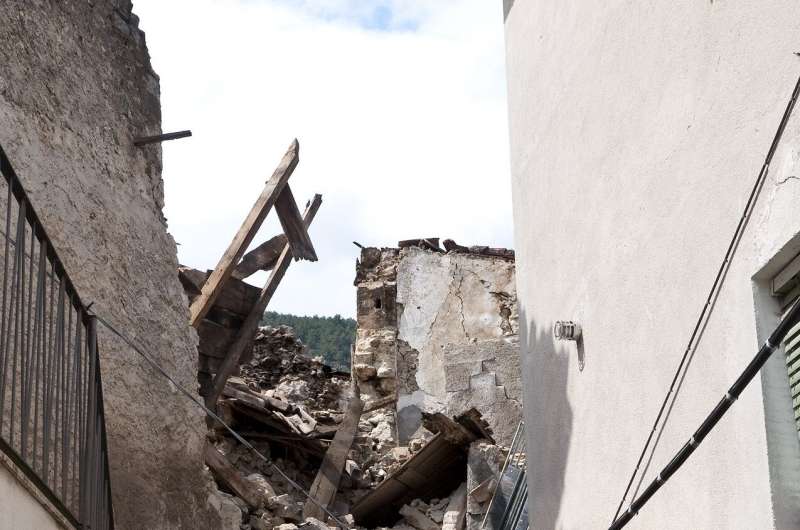This article has been reviewed according to Science X's editorial process and policies. Editors have highlighted the following attributes while ensuring the content's credibility:
fact-checked
peer-reviewed publication
trusted source
proofread
Research reveals new insights into soil liquefaction during earthquakes

Soil liquefaction, a destructive phenomenon occurring during earthquakes, has traditionally been associated with undrained conditions near the earthquake epicenter. However, new research conducted by Dr. Shahar Ben-Zeev at The Hebrew University of Jerusalem and the University of Strasbourg has unveiled a remarkable discovery—liquefaction can occur under drained conditions even at remarkably low seismic-energy density levels. This research offers a comprehensive explanation for earthquake far-field liquefaction events that have long puzzled scientists.
The work is published in Nature Communications.
Soil liquefaction is a natural hazard that commonly occurs during earthquakes. Liquefaction is one of the most catastrophic earthquake-related phenomena. During and after liquefaction, buildings and infrastructures sink, float and tilt, ground might spread and crack, settle, or initiate a landslide. Liquefaction damage often leads to extensive human casualties, destruction of lifelines, and economic losses that may result in the complete abandonment of formerly inhabited areas, posing a significant challenge to community resilience.
Traditionally, liquefaction has been understood as a predominantly undrained process that occurs under high-energy density conditions. This conventional view left many earthquake liquefaction events unexplained, particularly those occurring far from the earthquake epicenter, where energy density is significantly lower.
Dr. Shahar Ben-Zeev, guided by Prof. Einat Aharonov from The Hebrew University of Jerusalem, Prof. Renaud Toussaint from the University of Strasbourg, and Prof. Liran Goren from Ben Gurion University, conducted this research, challenging conventional wisdom.
Their findings demonstrate that liquefaction can indeed occur under drained conditions, even at low seismic-energy density levels. Seismic shaking, under drained conditions, facilitates interstitial fluid flow within the soil, leading to the development of excess pore pressure gradients and subsequent soil strength loss. Drained liquefaction occurs rapidly and is influenced by the rate of seismic-energy injection.
These findings have important implications for our understanding of soil liquefaction. By considering soil liquefaction under a spectrum of drainage conditions, we can now more accurately assess its potential and associated hazards. This research opens new doors for earthquake engineering and preparedness, assisting in the mitigation of risks associated with soil liquefaction in regions vulnerable to seismic activity.
What sets this study apart is its unique combination of theoretical work, numerical simulations, and experimental validation.
Furthermore, in an era marked by a continual increase in the construction of reclaimed land and artificial islands, both highly susceptible to soil liquefaction, this research becomes even more pertinent.
As most of the past earthquakes occurred before the modern instrumental era, seismologists rely heavily on the interpretation of geological features to compile complete earthquake catalogs. This groundbreaking study fundamentally shifts our understanding of the conditions that may have caused liquefaction-related geological features, hence calling for revising the estimated earthquake magnitude calculated by standard methods.
Dr. Shahar Ben-Zeev's work significantly contributes to our understanding of earthquake-induced soil liquefaction and emphasizes the need to reevaluate liquefaction potential assessments. This research offers invaluable insights into addressing one of the most destructive consequences of earthquakes, providing hope for enhanced resilience in earthquake-prone areas.
In summary, comprehending soil liquefaction is crucial as it directly affects public safety, infrastructure resilience, water resources, and the ability to manage and mitigate earthquake consequences in susceptible regions. This research substantially advances our understanding, offering vital insights for earthquake safety and disaster preparedness.
More information: Drainage explains soil liquefaction beyond the earthquake near-field, Nature Communications (2023). DOI: 10.1038/s41467-023-41405-4. www.nature.com/articles/s41467-023-41405-4
Journal information: Nature Communications
Provided by Hebrew University of Jerusalem



















